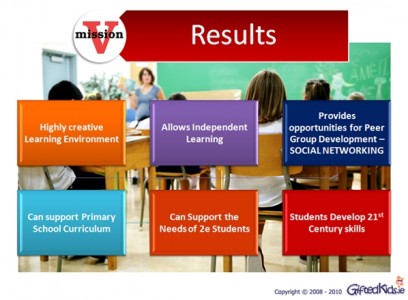MissionV – 3D Immersive Technology in the classroom for the support of exceptionally able and twice exceptional students
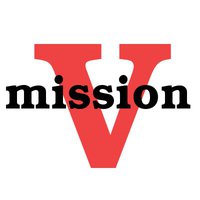 What if you were told of an amazing untapped, sustainable national resource that has been discovered yet is not being exploited? I’m pretty sure your interest would be piqued, particularly in the current economic climate where our future lies in our ability as a nation to capitalise on our resources and strengths. What is this resource? And, more importantly, why is it not being utilised in the endeavours to steer our economy towards recovery?
What if you were told of an amazing untapped, sustainable national resource that has been discovered yet is not being exploited? I’m pretty sure your interest would be piqued, particularly in the current economic climate where our future lies in our ability as a nation to capitalise on our resources and strengths. What is this resource? And, more importantly, why is it not being utilised in the endeavours to steer our economy towards recovery?
In Ireland we have an estimated 27,000 exceptionally able children; those in the 95th percentile and above of cognitive ability. Unlike other countries, there is no co-ordinated effort to reach this group of students at either primary or second level. These students stand out from their peers in three keys ways, they learn faster, earlier and differently and require a greater depth and breadth of curriculum if they are to realise their full potential. Countries as diverse as China, Saudi Arabia, Australia and Canada see the value of supporting their exceptionally able students and are investing in gifted education programmes. These economies realise that it is amongst this group that you will find the future technologists, scientists and innovators of tomorrow and that by supporting these students they are securing their country’s future in the smart economy. Yet, the Irish Education system continues to ignore the real value of these students and as a result many are failing to achieve a fraction of their potential and are seriously underachieving. This is a huge and totally avoidable loss, culturally, economically and socially to our country.
Problems facing Exceptionally Able Students in ireland
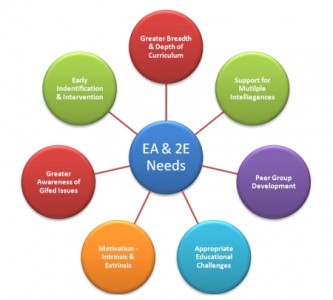 We know from the Giftedkids.ie Community Forum that teachers want to support high ability students, yet there is little if any teacher training in gifted education at the primary degree level. Identification is also problematic, particularly for those children with English as a second language, children from disadvantaged backgrounds and children with additional behavioural or learning differences such as Aspergers, ADHD or Dyslexia. Many people are unaware that exceptionally able and twice exceptional children can come from all socio-economic backgrounds, from all communities and can present with often crippling disabilities or challenging learning differences. Gifted learners are not an easily identifiable homogenous group. “Giftedness†is a spectrum ranging from high ability through to profoundly gifted and can encompass a range of abilities across a range of areas (see Gardner’s theory of multiple intelligences). Any intervention for this group must be cognisant of that fact. In addition although this group of students were identified as having special educational needs in the 1998 Education Act, all references to this group were purged from the EPSEN Act 2004 leaving them and their teachers with no support or direction.
We know from the Giftedkids.ie Community Forum that teachers want to support high ability students, yet there is little if any teacher training in gifted education at the primary degree level. Identification is also problematic, particularly for those children with English as a second language, children from disadvantaged backgrounds and children with additional behavioural or learning differences such as Aspergers, ADHD or Dyslexia. Many people are unaware that exceptionally able and twice exceptional children can come from all socio-economic backgrounds, from all communities and can present with often crippling disabilities or challenging learning differences. Gifted learners are not an easily identifiable homogenous group. “Giftedness†is a spectrum ranging from high ability through to profoundly gifted and can encompass a range of abilities across a range of areas (see Gardner’s theory of multiple intelligences). Any intervention for this group must be cognisant of that fact. In addition although this group of students were identified as having special educational needs in the 1998 Education Act, all references to this group were purged from the EPSEN Act 2004 leaving them and their teachers with no support or direction.
Put the “Smart†in “Smart Economyâ€
We are constantly hearing references to the smart economy and how our schools need to help students develop 21st century skills. Yet we are not being very “smart†about how we are funding our schools or supporting our teachers so that they can fulfil that brief. We seem to be constantly asking more of our teachers without the necessary framework or training. Earlier this year the team at Giftedkids.ie began to look at practical solutions to this problem and particularly that of identification and support of exceptionally able and twice exceptional students. Partnering with the National Centre for Technology in Education we began a free series of online webinars focusing on key issues facing exceptionally able students, their families and educators. This recorded series, which now forms the basis of a growing resource library, can be viewed and the presentations downloaded from our site (http://www.giftedkids.ie). At the same time we were also anxious to look at new and innovative teaching tools which could be used with this group of students in the classroom. One of the most exciting and innovative ideas was the possible use of 3D immersive technology. We felt that this type of technology would have a particular resonance with this group of students offering as it did a highly creative learning environment with an opportunity for group and individual project based learning. Our fellow Social Entrepreneur Awardees James Corbett and Keith Kennedy of Daynuv, a company specialising in 3D immersive technology for education, then came on board to partner with us on a unique pilot based in Carlow Gaelscoil, Eoghan Uà Thuarisc, a project we called MissionV – V for virtual and in honour of our first five “Missionersâ€.
3d immersive technology – A Solution
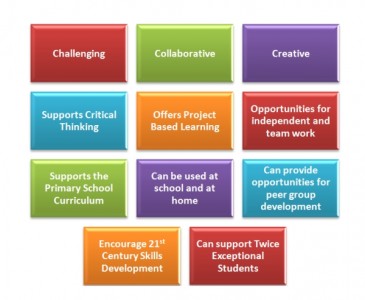
Beyond the “3 R”s – introducing the “3 C”s: “connectâ€, “create†, “collaborate†– MissionV takes off!
 MissionV is an innovative 3D online learning environment where exceptionally able and twice exceptional primary school students have the opportunity to connect, create and collaborate. Our highly successful pilot project, based in a national school in Carlow, demonstrates that 3D learning software can help this group of students to unlock abilities which can go unnoticed in a traditional learning environment. In response to school and learning support enquiries we intend to roll out this project to a further 19 primary schools (20 schools in total) within this school year (2010/2011). Following the hugely positive response to the pilot we are currently exploring a number of possible funding partnerships to facilitate this rollout.
MissionV is an innovative 3D online learning environment where exceptionally able and twice exceptional primary school students have the opportunity to connect, create and collaborate. Our highly successful pilot project, based in a national school in Carlow, demonstrates that 3D learning software can help this group of students to unlock abilities which can go unnoticed in a traditional learning environment. In response to school and learning support enquiries we intend to roll out this project to a further 19 primary schools (20 schools in total) within this school year (2010/2011). Following the hugely positive response to the pilot we are currently exploring a number of possible funding partnerships to facilitate this rollout.
The Pilot
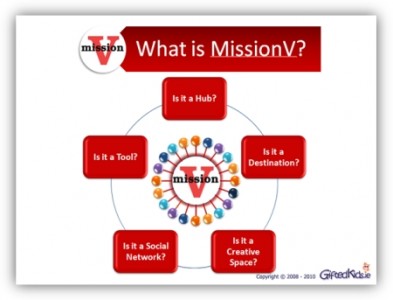
In February this year Daynuv created a private and secure virtual world called MissionV. This ‘deserted island’ was quickly peopled with avatars and architectural structures created by a group of five exceptionally able students from Gaelscoil Eoghan UÃ Thuarisc under the guidance of their learning support teacher Brid UÃ Mhaoluala.
Brid has been teaching small groups of exceptionally able children for the past number of years at the school and was interested in using this type of technology to provide enrichment material for her current group of students.
“I am fortunate that we have a very supportive principal and staff and that my Learning Support colleagues have worked with me to create some time for the exceptionally able children. Of course, time is always the enemy and we worked the Daynuv project for two periods a week in school, but the children continued to work on the project at home. A special word of thanks must go to the parents of our five participants who were more than willing to let their children get involved and to support them at home.â€
“In the past few years, our exceptionally able students have done things as diverse as building a Morse code machine, creating PowerPoint presentations on the Famine, written their own novels and researched and demonstrated scientific experiments to their classmates. Sometimes, I felt the children were doing projects or tasks almost to please me, rather than for themselves. I was delighted to be included in this pilot where the children could work on what they wanted and on something truly challenging. I am not a techno-wizard, I don’t even have an ECDL, so by taking this on, I felt I would be able to say to any teacher that if I could do it, anyone could. James was always on hand to help and advice.â€
After some initial training the students quickly got to grips with the software and soon built a 3D world based on a number of local structures such as the Castledermot high crosses. Prior to starting their 3D virtual world building project, the students made a site visit, mapped out the terrain and took digital photos which they then uploaded to their computers, so that these “textures†could be imported int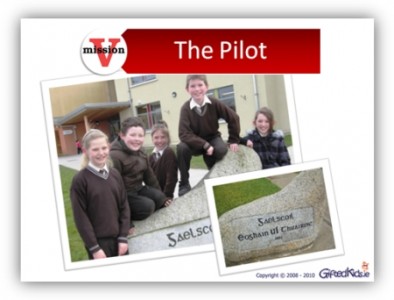 o the programme and used to create the right effects for stonework, etc.
o the programme and used to create the right effects for stonework, etc.
But this was just the beginning of an ambitious building project that soon veered skywards to their “City in the Skyâ€, including a huge chess board in the town square. The students also enjoyed a virtual visit by award winning children’s author, Bob Burke with a lively Q&A session.
The students access MissionV both at home and at school and interact via their avatars with the virtual environment and with each other. Parental agreement was sought to facilitate home access.
The Results
“MissionV stretched my students in ways I could not, it was pupil driven rather than driven by me, it allowed us to integrate subject areas – e.g. local history with construction and it improved team work and social skills. As I was leaving school yesterday, they wanted to know if they could continue to build during the summer!†– Brid Uà Mhaoluala
What the Students Say
“I built a fort and have almost completed a house. My friend built a sky scraper. It’s fun to be on; you can build modern houses or a medieval castle . . . owning our own island is cool!” – Odhrán
“I think Daynuv is fun and a great way to let your imagination run wild in your own virtual world. I would definitely recommend it for children age 10-14. You can create anything from a castle to a shopping centre. Interacting on site with other users in class or at home is what I enjoy most.” – SÃobhra
“I like Daynuv, because you can build and design on your own island. You can build and create anything at all and make it as complicated as you want. The way you can talk to your friends on it is a great idea because if you are building anything big it helps, as you can plan and build together and get to know other people if the island is “opened up.” I like the idea that when a building is not built properly it will fall down.” – Niamh
“Daynuv is not a game, it is a hobby and a tool. When such a programme, granting the ability to create anything and the chance to interact with other people, is used in the education of children the possibilities are massive. The programme allows children to understand architecture. The control of the land is excellent. Not only can buildings be erected but looking out on the horizon we can see mountains, lakes and valleys of our own creation. In creating replicas of true buildings we gain a deeper knowledge of the processes, toils and triumphs used in building. The programme is enjoyable to use and is a fascinating meeting place for classmates.” – Conor
Summary
No one can deny the sudden dominance of 3D technology in our lives; it’s in our homes, in our cinemas and on our gaming consoles. 3D technology is entirely revolutionary and is set to redefine how we and our children see and interact with multimedia and technology. In fact your students are probably way ahead of the game, as they look forward to the Xbox Kinect, launched on November 10th and the 3DS due in March 2011. There is general agreement amongst educators and parents that the time is ripe for significant changes to our education system. Our children have 21st century expectations, thanks to home computing, gaming and the media they watch, yet the majority learn in a 20th century school room. We need change but how far are we willing to go and how quickly?
MissionV provides students with a totally blank canvas, a 16 acre virtual world for each school where “Missioners†can build original constructs, model buildings from the real world, role-play characters from Irish history while re-enacting historical events, host virtual visits by guest speakers and get involved in etwinning with schools across the world. NASA have just spent over a quarter of a million dollars on their “Moon World†virtual world project, based on the same open simulator platform we use for MissionV. Our “Missioners†are actually building a moon base as this goes to print! MissionV is helping these students to become orginal digital creators rather than consumers and that is the kind of skills set that our children need if we are to prepare them for this brave new world of the smart economy and allow them to compete globally. If we are to attract foreign investment in the future it will be because of our skilled workforce. And, to get back to my original point, this is why we need to invest now in our exceptionally able and twice exceptional students.
MissionV continues in Carlow Gaelscoil with an additional two students now included in the pilot. If funding can be obtained the project will be extended to a further 19 schools nationwide, with a mix of patronage, size and status reflecting the diversity of schools and the exceptionally able student population. We will also have in place a website which will become a 3D learning zone where teachers and students involved in the project can collaborate on projects, seek advice and share resources. To learn more, click here.
- Ireland’s gifted kids explore 3D - November 15, 2010

